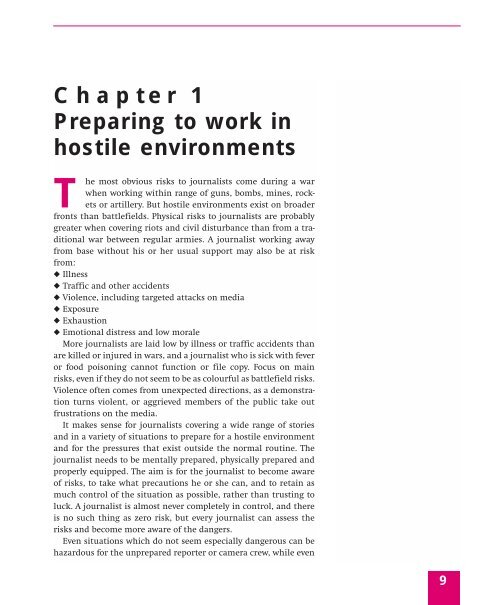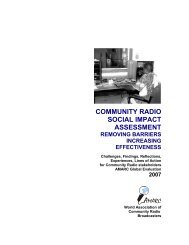Live News - A Survival Guide - International Federation of Journalists
Live News - A Survival Guide - International Federation of Journalists
Live News - A Survival Guide - International Federation of Journalists
- No tags were found...
Create successful ePaper yourself
Turn your PDF publications into a flip-book with our unique Google optimized e-Paper software.
Chapter 1Preparing to work inhostile environmentsThe most obvious risks to journalists come during a warwhen working within range <strong>of</strong> guns, bombs, mines, rocketsor artillery. But hostile environments exist on broaderfronts than battlefields. Physical risks to journalists are probablygreater when covering riots and civil disturbance than from a traditionalwar between regular armies. A journalist working awayfrom base without his or her usual support may also be at riskfrom:◆ Illness◆ Traffic and other accidents◆ Violence, including targeted attacks on media◆ Exposure◆ Exhaustion◆ Emotional distress and low moraleMore journalists are laid low by illness or traffic accidents thanare killed or injured in wars, and a journalist who is sick with feveror food poisoning cannot function or file copy. Focus on mainrisks, even if they do not seem to be as colourful as battlefield risks.Violence <strong>of</strong>ten comes from unexpected directions, as a demonstrationturns violent, or aggrieved members <strong>of</strong> the public take outfrustrations on the media.It makes sense for journalists covering a wide range <strong>of</strong> storiesand in a variety <strong>of</strong> situations to prepare for a hostile environmentand for the pressures that exist outside the normal routine. Thejournalist needs to be mentally prepared, physically prepared andproperly equipped. The aim is for the journalist to become aware<strong>of</strong> risks, to take what precautions he or she can, and to retain asmuch control <strong>of</strong> the situation as possible, rather than trusting toluck. A journalist is almost never completely in control, and thereis no such thing as zero risk, but every journalist can assess therisks and become more aware <strong>of</strong> the dangers.Even situations which do not seem especially dangerous can behazardous for the unprepared reporter or camera crew, while even9
















